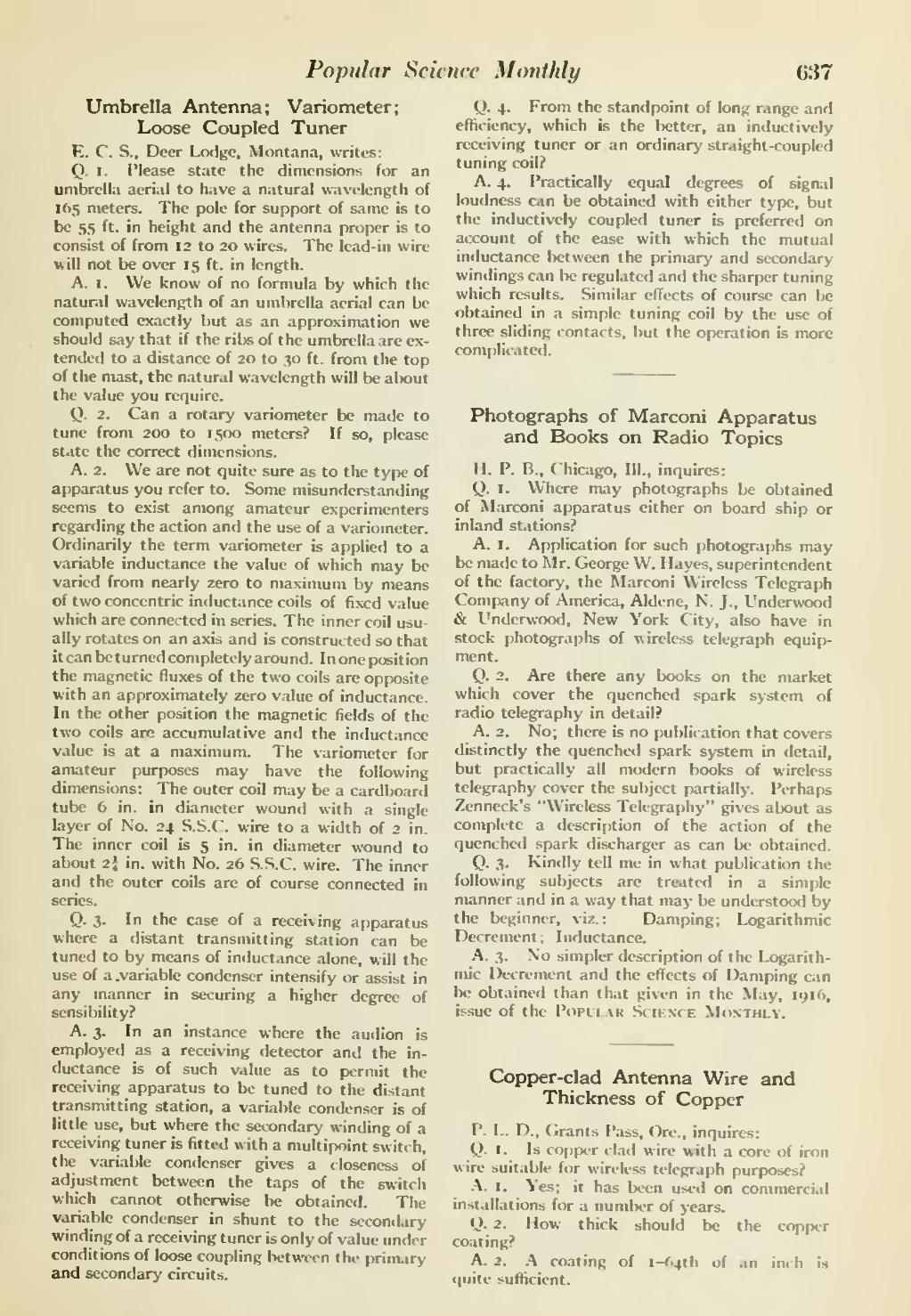Popular Science Monthly
��637
��Umbrella Antenna; Variometer; Loose Coupled Tuner
E. C. S., Deer Lodge, Montana, writes:
Q. 7. Please state the dimensions for an umbrella aerial to have a natural wavelength of 165 meters. The pole for support of same is to be 55 ft. in height and the antenna proper is to consist of from 12 to 20 wires. The lead-in wire will not be over 15 ft. in length.
A. I. We know of no formula by which the natural wavelength of an umbrella aerial can be computed exactly but as an approximation we should say that if the ribs of the umbrella are ex- tended to a distance of 20 to 30 ft. from the top of the mast, the natural wavelength will be about the value you require.
Q. 2. Can a rotary variometer be made to tune from 200 to 1500 meters? If so, please state the correct dimensions.
A. 2. We are not quite sure as to the type of apparatus you refer to. Some misunderstanding seems to e.xist among amateur experimenters regarding the action and the use of a variometer. Ordinarily the term variometer is applied to a variable inductance the value of which may be varied from nearly zero to maximum by means of two concentric inductance coils of fixed value which are connected in series. The inner coil usu- ally rotates on an axis and is constructed so that it can be turned completely around. In one position the magnetic fluxes of the two coils are opposite with an approximately zero value of inductance. In the other position the magnetic fields of the two coils are accumulative and the inductance value is at a maximum. The variometer for amateur purposes may have the following dimensions: The outer coil may be a cardboard tube 6 in. in diameter wound with a single layer of No. 24 S.S.C. wire to a width of 2 in. The inner coil is 5 in. in diameter wound to about 2i in. with No. 26 S.S.C. wire. The inner and the outer coils are of course connected in scries.
Q. 3. In the case of a receiving apparatus where a distant transmitting station can be tuned to by means of inductance alone, will the use of a. variable condenser intensify or assist in any manner in securing a higher degree of sensibility?
A. 3. In an instance where the audion is employed as a receiving detector and the in- ductance is of such value as to permit the receiving apparatus to be tuned to the distant transmitting station, a variable condenser is of little use, but where the secondary winding of a receiving tuner is fitted with a multipoint switch, the variable condenser gives a closeness of adjustment between the taps of the switch which cannot otherwise he obtained. The variable condenser in shunt to the secondary winding of a receiving tuner is only of value under conditions of loose coupling iK'twecn the primary and secondary circuits.
��Q. 4. From the standpoint of long range and efficiency, which is the better, an inductively receiving tuner or an ordinary straight-coupled tuning coil?
A. 4. Practically equal degrees of signal loudness can be obtained with either type, but the inductively coupled tuner is preferred on account of the ease with which the mutual inductance between the primary and secondary windings can be regulated and the sharper tuning which results. Similar ciTects of course can be obtained in a simple tuning coil by the use of three sliding contacts, but the operation is more complicated.
��Photographs of Marconi Apparatus and Books on Radio Topics
H. P. B., Chicago, 111., inquires:
Q. I. Where may photographs be obtained of Marconi apparatus cither on board ship or inland stations?
A. I. Application for such photographs may be made to Mr. George W. Hayes, superintendent of the factory, the Marconi Wireless Telegraph Company of America, Aldene, N. J., Underwood & Underwood, New York City, also have in stock photographs of wireless telegraph equip- ment.
Q. 2. Are there any books on the market which cover the quenched spark system of radio telegraphy in detail?
A. 2. No; there is no publication that covers distinctly the quenched spark system in detail, but practically all modern books of wireless telegraphy cover the subject partially. Perhaps Zenneck's "Wireless Telegraphy" gives about as complete a description of the action of the quenched spark discharger as can be obtained.
Q. 3. Kindly tell me in what publication the following subjects are treated in a simple manner and in a way that may be understood by the beginner, viz.: Damping; Logarithmic Decrement; Inductance.
A. 3. No simpler description of the Logarith- mic Decrement and the effects of Damping can be obtained than that given in the .May, 1916, issue of the Popi'i..\R Science Mo.sthlv.
��Copper-clad Antenna Wire and Thickness of Copper
P. L. D., Grants Pass, Ore., inquires:
O. I. Is copper clad wire with a core of iron wire suitable for wireless telegraph purposes?
A. I. Yes; it has been used on commercial installations for a numlx-r of years.
Q. 2. How thick should be the copper coat ing?
A. 2. .-K coating of i-f)4th of an inch is <|uite sufficient.
�� �
